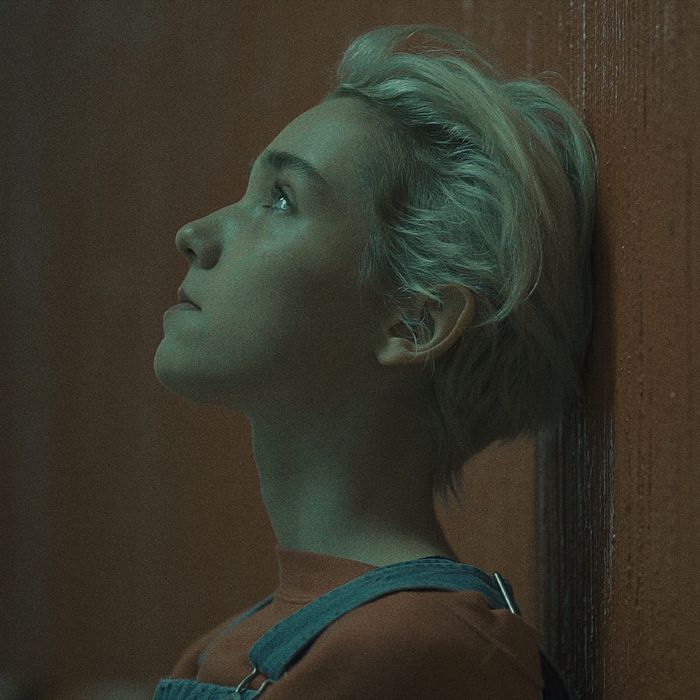
Julia Sarah Stone in Come True. Photo: Courtesy of IFC Midnight
There are only a couple of jump scares in Anthony Scott Burns’s Come True — mild ones at that — but the movie’s elusive sense of menace lingers for days, weeks, possibly forever. That’s quite an achievement for a film whose premise isn’t particularly novel. We all know dreams can be scary; everything from A Nightmare on Elm Street to The Prince of Darkness to Paperhouse taught us that. But Come True embraces this chilling idea: Dreams are scary because we still don’t entirely know what they are. Something similar can be said about this slippery, unsettling little film, which is being released by IFC Midnight on demand and in theaters.
Start with the protagonist. We don’t know much about 18-year-old Sarah (Julia Sarah Stone) other than the fact that she has trouble sleeping and something is keeping her from going home. She’s not quite a runaway: She still attends school, and occasionally sneaks into her house, fleeing out the window before her mom can find her. (There’s a lingering hint of abuse, but, like so much else in the film, very little is stated outright.) She crashes at a friend’s when she can, and on a children’s playground when she can’t, lying on a slide and looking at the stars, waiting for them to melt into the pitch-black landscape of her nightmares. Sarah has bad dreams, when she can even manage to sleep.
Burns — a Canadian director who also wrote, shot, edited, designed the visual effects, and co-composed the drifty, droney, dreamy score under his moniker Pilotpriest — films the world around Sarah in dim light, the colors muted. Hers is an anxious, half-awake reality, neither here nor there, always ready to slip into darkness. Amid this oppressive gloom, Stone’s sallow, hangdog visage suggests someone wasting away before our very eyes. So, when Sarah decides to sign up for a local lab’s sleep study experiment, even the audience feels some relief. At least she’ll get some rest now, we think. So what if it involves a bunch of strangers asking prying questions and plugging cables to her head? Indeed, after Sarah experiences one good night of slumber, we get our first glimpse of sunlight, and a smile starts to creep onto our hero’s face. It doesn’t last long.
Much of the story, such as it is, involves Sarah’s relationship with Jeremy (Landon Liboiron), one of the researchers running the sleep study, whose motives she begins to question when he takes a more-than-professional interest in her. But Come True truly comes to life whenever Burns portrays the unnerving, spectral world of Sarah’s dreams, with their grim meadows, gray halls, and surreal objects. The camera glides through pieces of a broken face, up ancient steps and through caves made of nails (or are they teeth?), into gates made of hands (or are they bodies?), onto darkened fields of fallen statues (or are they frozen corpses?). The imagery is foggy, forbidding, and eerily uncertain.
At the center of this psychic wasteland often stands a long, thin, shadowy form, who seems to dominate both Sarah’s and the other subjects’ nightmares. The scientists are fascinated by this figure. Is it a shared fear, a lurking, ancient threat from humanity’s before times? The film doesn’t provide many answers, but it’s all just suggestive enough to send our minds racing. We don’t know what this thing is, or what it can do, which when you think about it means it could be and do anything. That sounds like an abstract notion, but Burns brings emotional weight to it. He captures something elemental, a vague but familiar terror scratching at the edge of our consciousness. I don’t think I’ve ever had dreams like the ones in Come True, but I know I’ve always feared having dreams like the ones in Come True.
Tense and oblique, the picture goes to some truly strange places, including one last, crazy twist that literally made me howl. I won’t ruin it here, but you will never ever guess in a million years what the final image of this movie is. Those looking for answers may be disappointed by it; if anything, it only provokes more questions. But those hoping to live with the film’s elegantly uncanny mysteries might be similarly disappointed, if only because it seems to send everything in a rather unlikely direction. For those who do see Come True (and really, if you’re into minor-key indie horror, you really should check it out) and have questions, I will simply say this: Maybe that final image isn’t meant for the characters, but for us.
Article From & Read More ( Movie Review: Come True, IFC horror film w/ a twist ending - Vulture )https://ift.tt/30zDsfk
Film
Bagikan Berita Ini














0 Response to "Movie Review: Come True, IFC horror film w/ a twist ending - Vulture"
Post a Comment